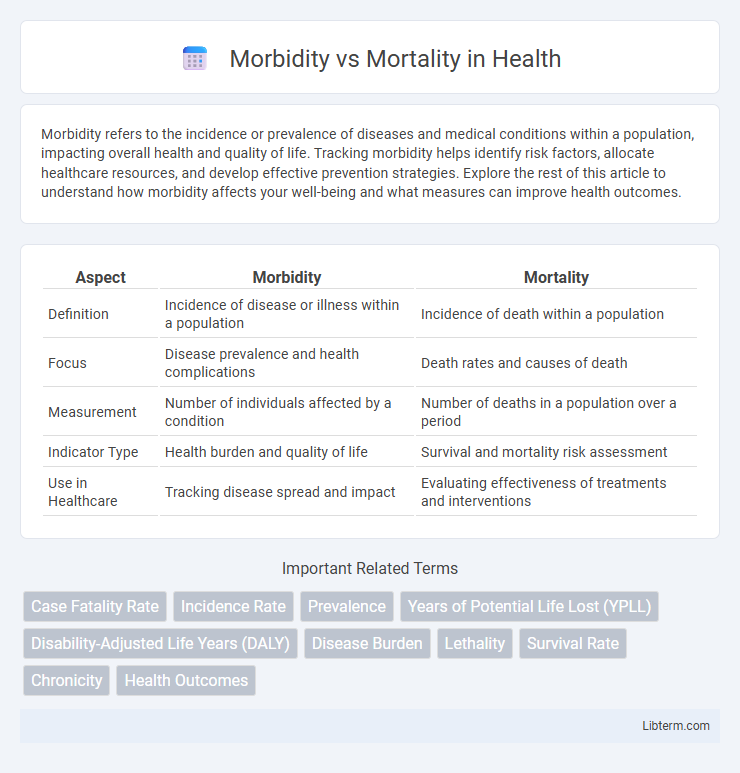Morbidity refers to the incidence or prevalence of diseases and medical conditions within a population, impacting overall health and quality of life. Tracking morbidity helps identify risk factors, allocate healthcare resources, and develop effective prevention strategies. Explore the rest of this article to understand how morbidity affects your well-being and what measures can improve health outcomes.
Table of Comparison
| Aspect | Morbidity | Mortality |
|---|---|---|
| Definition | Incidence of disease or illness within a population | Incidence of death within a population |
| Focus | Disease prevalence and health complications | Death rates and causes of death |
| Measurement | Number of individuals affected by a condition | Number of deaths in a population over a period |
| Indicator Type | Health burden and quality of life | Survival and mortality risk assessment |
| Use in Healthcare | Tracking disease spread and impact | Evaluating effectiveness of treatments and interventions |
Introduction to Morbidity and Mortality
Morbidity refers to the incidence or prevalence of diseases and health conditions within a population, indicating the burden of illness and its impact on quality of life. Mortality measures the frequency of death in a population, often expressed as a death rate, reflecting the severity and fatality of diseases. Understanding morbidity alongside mortality provides comprehensive insights into public health challenges, guiding medical research and healthcare policy.
Defining Morbidity
Morbidity refers to the incidence or prevalence of disease, illness, or disability within a population, indicating the rate at which individuals experience health complications. Unlike mortality, which measures death rates, morbidity focuses on the quality of health and the burden of non-fatal conditions such as chronic diseases, infections, and injuries. Tracking morbidity helps public health officials identify patterns of illness and allocate resources for prevention and treatment.
Understanding Mortality
Mortality measures the frequency of death within a population, providing crucial data for assessing public health impact and guiding healthcare policies. It is often expressed through mortality rates such as crude death rate, infant mortality rate, and age-specific mortality rate, which highlight different demographic vulnerabilities. Understanding mortality patterns helps identify leading causes of death, improving resource allocation and preventive strategies to reduce fatal outcomes.
Key Differences Between Morbidity and Mortality
Morbidity refers to the incidence or prevalence of diseases and health conditions in a population, highlighting the impact of illness on quality of life and functional status. Mortality measures the frequency of death within a population, serving as a critical indicator of health outcomes and life expectancy. The key difference lies in morbidity emphasizing disease burden and chronic conditions, while mortality focuses on death rates and survival statistics.
Common Causes of Morbidity
Common causes of morbidity include chronic diseases such as diabetes, hypertension, and respiratory infections, which significantly impact quality of life and healthcare resources. Infectious diseases like influenza, tuberculosis, and HIV/AIDS remain major contributors to morbidity rates worldwide. Mental health disorders, including depression and anxiety, are increasingly recognized as prevalent causes of morbidity, affecting both physical health and social functioning.
Leading Causes of Mortality
Leading causes of mortality primarily include cardiovascular diseases, cancers, respiratory infections, and chronic respiratory diseases, which significantly contribute to global death rates. Morbidity pertains to the prevalence of diseases and conditions that impact quality of life but may not always result in death, whereas mortality strictly refers to the incidence of death within a population. Understanding mortality trends helps prioritize healthcare resources and interventions to reduce fatal outcomes from key diseases like ischemic heart disease and stroke.
Measuring Morbidity: Indicators and Metrics
Measuring morbidity involves various indicators such as incidence rate, prevalence, and disability-adjusted life years (DALYs) to assess the frequency and impact of diseases within a population. Incidence rate quantifies new cases over a specified period, while prevalence captures the total number of existing cases at a given time, providing insights into disease burden. Disability-adjusted life years combine years of life lost due to premature death and years lived with disability, offering a comprehensive metric for evaluating overall health impact.
Mortality Rates: Calculation and Interpretation
Mortality rates are calculated by dividing the number of deaths in a specified population during a given time period by the total population at risk, often expressed per 1,000 or 100,000 individuals to standardize comparisons. Accurate interpretation of mortality rates requires consideration of factors such as age distribution, cause-specific death, and population demographics to assess disease impact and public health outcomes effectively. Mortality rate analysis assists in identifying trends, evaluating healthcare interventions, and guiding policy decisions to reduce preventable deaths.
Public Health Significance of Morbidity and Mortality
Morbidity refers to the incidence and prevalence of diseases or health conditions within a population, while mortality denotes the rate of death caused by these conditions. Understanding morbidity patterns helps public health officials identify disease burden and allocate resources effectively for prevention and treatment. Mortality data provide critical insights into the lethality of illnesses and guide policy decisions aimed at reducing premature deaths and improving overall population health.
Strategies to Reduce Morbidity and Mortality
Implementing widespread vaccination programs significantly reduces morbidity and mortality rates associated with infectious diseases by enhancing population immunity. Strengthening healthcare infrastructure and ensuring timely access to quality medical care improve early diagnosis and treatment outcomes for chronic and acute conditions. Promoting public health initiatives such as smoking cessation, healthy diet, and regular physical activity lowers the incidence of non-communicable diseases, thereby decreasing both morbidity and mortality.
Morbidity Infographic

 libterm.com
libterm.com